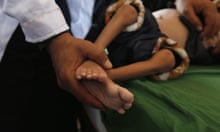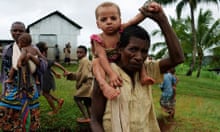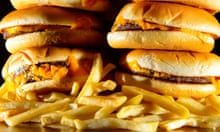Children under the age of two in Nepal are getting a quarter of their calories from junk food, according to groundbreaking research that warns their diet is linked to stunting and undernutrition.
Biscuits, crisps, instant noodles and sugary drinks appear to be displacing foods with the vitamins, minerals and other vital nutrients babies need to grow well, say the researchers. The work, published in the Journal of Nutrition, illustrates that the 21st-century junk food diet spreading around the globe is linked not just to obesity but also to poor growth in children.
The study was carried out in the Kathmandu Valley among the families of 745 children aged between 12 and 23 months. It is among the first to look at the nutritional effects of snack foods given to small children in a low-income country. The researchers work for Helen Keller International, a global health organisation.
They found that all the children in the study ate junk food, some more than others. Those who got half their calories from high-sugar, high-salt and high-fat snacks were shorter than others of their age who ate less of them. They were more likely to have inadequate levels of the nutrients that are vital for growth and development, including protein, calcium, iron, vitamin A and zinc.
“We hope these findings sound the alarm for researchers and policymakers alike – there is a need for continued research on the role of snack food products in the health and development of nutritionally vulnerable children,” said Dr Alissa Pries, the principal investigator of the Assessment and Research on Child Feeding project.
“Packaged snack food products – typically high in sugar and salt and low in micronutrients – are increasingly available across the globe. There is already growing global concern in the health community over the role of junk foods or ultra-processed foods in the obesity epidemic, but for young children in contexts where access to nutritious food is limited, this study signals that these foods may also be contributing to undernutrition.”
Snack foods, some processed and packaged locally and some of them international, were common all over Nepal, even in remote places, she said. “They are available on the shelves. There is marketing that is occurring. Mothers and fathers choose these products, as in the US and UK, because they are convenient – and the child gets a preference for these sugary snacks.
“A lot of the caregivers reported that the foods were not good for young children – they used the English words ‘junk food’ – but they said the driving force was convenience. They are easy to prepare and easy to feed. Children can hold them and eat them.”
Pries said she was disturbed by the findings. “Knowing that a quarter of all the calories that these babies were consuming were coming from unhealthy food and beverages – to me that was shocking,” she told the Guardian. “The prevalence of consumption of these foods is growing. We are seeing it globally.”
The study was observational, so could not prove cause and effect, but the authors are calling for more research into the potentially damaging developmental effects of junk food on small children.
“There is growing evidence that children are consuming unhealthy snack products at a shocking rate,” said Dr Atul Upadhyay, a co-author on the paper. “More attention and efforts need to focus on increasing consumption of nutrient‐rich, locally available foods and developing strategies to limit consumption of unhealthy snack products among young children.”








